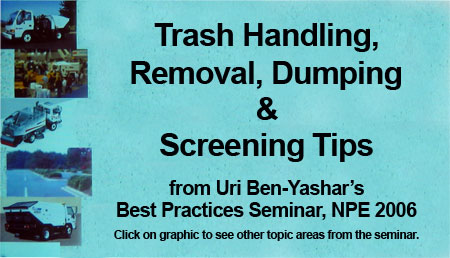Best Practices |
Screening of Parking Lot and Street Sweeper Debris
This information was provided by one of the focus groups at the seminar organized by Uri Ben-Yashar at NPE 2006. This focus group provided an overview on debris handling and screening as they apply to parking area sweeping.Topic area moderator was Kerry Armstrong, principal in Armstrong Sweeping, Inc. Kerry was also the presenter for the topic.by Ranger Kidwell-Ross
"I was forced into debris screening at our Colorado location when our trash haulers would no longer pick up dumpsters we emptied debris into," said Kerry Armstrong, who presented the information gleaned during his group's discussion on this topic. "They said it was too heavy. This forced me to get into debris screening early on. It was a very good decision." "At first, when our hauler found out the dumpster had sweeping debris in it, they doubled the price of pickup. That's what forced us to rethink what we'd been doing, even though disposal is relatively inexpensive in our area of Colorado, at $7/ton. If it was a money-saver to start screening for us, just think what it will do for other sweeping companies in areas where disposal fees are more. Our group recommendation is that if you do dispose via an onsite dumpster, don't pay for that dumpster yourself. Have the cost billed to the customer even if it's a dumpster you put the debris from several accounts into. That way, 'your' dumpster is mixed in with the others the customer has and it's not as likely to be spotted as one that's being filled with sweeper debris. You pay for the cost to your customer in that situation, of course." Although there are a number of good screens on the market, it is possible to build your own screening system. Basically, you need a sloped screen built such that the dirt will fall through in a pile and the other debris will slide down to the bottom. You can then deal with disposal of each component in a separate manner. Most of the dumps are going to weighing by the ton, instead of by the yard. Removing the dirt portion prior to landfilling reduces the biggest portion of the cost of disposal. In Colorado, we are able to dispose of the remainder (dirt) portion of the debris for no cost as clean landfill. There is no question that screening your debris is cost-effective and easy to do. You'll need an area where you can put your screening operation, but not all that much room is required. Most contractors use a skidsteer loader to move raw debris from a pile and put it onto the screener. Although there is some added cost for the needed support equipment and the screen, itself, in virtually any geographical location the resulting lower costs will provide a speedy payback of the investment. Prior to purchasing a screening machine and getting going with your screening operation you'll want to check with your local ordinances in this regard. Some jurisdictions, for example, require that the raw sweepings remain covered during storage. In other areas, you may have to ensure that any runoff from the pile is collected and/or filtered. In some locales, you may find that when you sweep up sand and then screen it you may be allowed to mix it back with raw sand so you can put it back down again as a snow traction aid. In most cases, though, you'll have to get into washing the material, as well, in order to do that. That's because the traffic over any sand put down as a traction aid will have created a large amount of fines, and you have to get those removed or they'll act like ball bearings instead of providing traction. Companies that sell screening equipment can assist you in determining your company's breakeven point when it comes to screening. The cost-effectiveness of adding a screener to your sweeping operation depends primarily upon your current (and future projected) cost of debris disposal. With the group of contractors at NPE, Kerry was confident he had lowered his long-term costs even though his disposal costs were a relatively low $7/ton. Other contractors in the room cited disposal at as high as $55/ton, in which case the payback for putting a screening operation in place occurred almost overnight. If you're in the middle range somewhere and have room at your location to store a pile of debris and install a screening operation, it's definitely something worth investigating. If you have any questions about any of the above ideas, feel free to contact the WorldSweeper.com Team for a further explanation. |
© 2005 - 2024
|
Parking Area Sweeping Contents
|